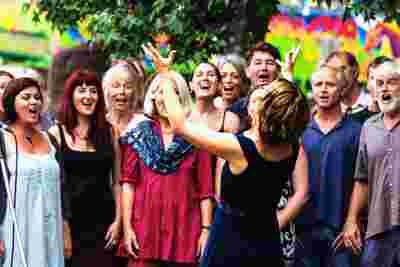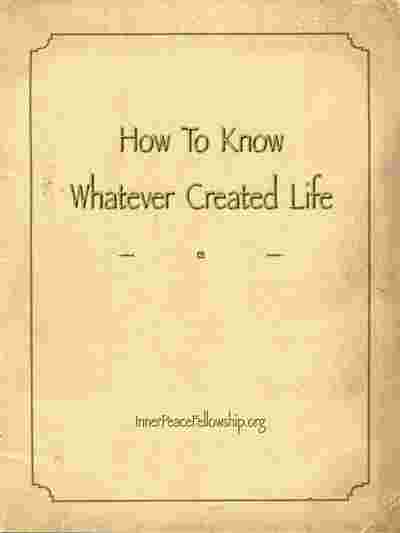Freedom Is Being Present
We live two lives: we live life in our thoughts and we live life as our experience of the present moment.
Freedom comes as our life in thoughts diminishes and our experience of the present moment predominates.
Freedom comes through learning how to balance thoughts and the present moment.
On This Page
Overview
We developed the ability to think abstractly only about 70,000 – 95,000 years ago*. Apparently the part of life we live “in our head” today simply did not exist before that time, and instead human life was solely a series of immediate experiences, like the lives of other creatures. (To learn more about “The Rise of Abstract Thinking” see the last section below.)
Abstract thinking has certainly improved the human condition but it has also created some serious problems. Stress accounts for over 60% of doctor visits and much of that stress results from people continually thinking and worrying about the past and the future. Often we literally “are not here” but instead are “in our head” thinking and worrying. It appears that meditation and other practices were originally developed as ways to help maintain a healthy balance of the life we live “in our head” and the life we live as immediate experiences.
In our Your Beliefs Quiz this question is asked: “Are there times during your day when you notice you have no thoughts?” Over 10,000 people have answered that question and 66% say they are thinking all the time while 34% say they notice some absence of thoughts during their day. The following are some of their written answers, which are reprinted here with their permission:
From those who say they never notice any absence of thoughts:
“I wish my brain would stop, but it goes on all the time worrying.”
“sometimes I try to just not think but I always end up thinking”
“There is not a single moment in the day where I have no thoughts”
“I always think. My mind races always.”
“My mind is usually a train-wreck. Thoughts whirl around my head constantly.”
From those who say they do notice the absence of thoughts:
“yes, that is when I am at peace”
“Yes, it’s nice.”
“during gardening”
“when I relax and meditate, my mind rests”
“It is a great feeling”
* E. O. Wilson; The Social Conquest of Earth; Liveright, 2013
Exercises
It appears that many people are thinking most of the time and would like to be thinking less. If you are one of them, then do these exercises:
As you read these words your attention is on the thoughts and ideas presented. As you read these words you are also aware of the light around you. Being aware of the light around you does not involve having any thoughts.
Now stop reading this, look around briefly, and come back to reading this. Do that now. Look around briefly and come back to reading this.
When you looked around you noticed things, and you noticed those things without thinking thoughts about them.
Just then when you noticed the light around you and then looked around briefly and noticed things, what you did was shift your attention away from your thoughts about these words and put your attention on what’s happening around you.
Having your attention on words and thoughts or having your attention on what’s happening around you is a choice you make about where to put your attention. If you choose to have your attention on thoughts, then thoughts will predominate, which in turn will obscure what is happening around you. On the other hand, if your attention is innocently noticing the light around you or innocently noticing things around you, then the light and the things around you will predominate, which in turn obscures thoughts.
To help you connect more with what is happening around you, do this exercise several times a week:
Notice the light around you and that you notice the light without thinking about it.
(For this exercise to work, you must not anticipate doing it. Instead, it should happen innocently and spontaneously.)
This exercise combined with regular meditation can help shift the balance from living life “in your head” towards living life more in the present moment.
In meditation thoughts tend to diminish at times and so you become more familiar with the silence and stillness that remain. Through meditating regularly, you become more and more familiar with that silence and stillness, which then helps you recognize and expand that silence and stillness in everyday life (see How To Meditate).
Spending time alone in nature is another way to become more familiar with and expand silence and stillness. Take long walks alone in the forest, fields or parks. (Note that when you walk in nature with someone else you tend to talk, which obscures silence.) To experience even deeper silence and stillness, put on a backpack, walk deep into nature and spend many days there alone. If you have children, take them camping and send them to a school held in nature that teaches them about nature.
For you however, meditation and time alone in nature may not shift the balance of thoughts and experience. For you, that balance may shift through gardening, dancing, yoga, singing, tai chi, sports, making music, knitting, etc. You are the only one who can know what shifts the balance for you from living life “in your head” towards living life more in the present moment.
And when you notice the silence and stillness, stay with them and sink into them.
Words and Teachings About Freedom
Silence and stillness – the absence of thoughts – cannot be known through thoughts and words. They can only be known through experiencing them, just as you can only know what honeysuckle smells like by experiencing the smell. Words can be written about the smell of honeysuckle, but words can never describe, contain or convey the smell of honeysuckle.
~ ~ ~
Freedom is about having fewer thoughts. However many people believe that freedom is gained by putting evermore thoughts and words into their head through studying teachings. Then what often happens is that all those words and thoughts become actual barriers to achieving freedom:
What happens is that when you start glimpsing the absence of thoughts you dismiss your glimpses as irrelevant to gaining freedom because your glimpses do not match up with any of the words and teachings you studied: no hidden reality is revealed; you do not become one with the universe; you do not become consciousness.
Or perhaps glimpsing the absence of thoughts feels pleasant to you. But feeling pleasant was not discussed in the teachings you studied about freedom. So again, you dismiss your glimpses of the absence of thoughts as irrelevant to achieving freedom and you continue on – endlessly looking for freedom and expecting that when you do find it, it will match up with the teachings you studied.
Learn to trust yourself and logic: how could your experience of the absence of thoughts match any words or teachings if the absence of thoughts cannot be described, contained or conveyed with thoughts and words. Your experience of freedom can never match any words or teachings.
Remember that through your own eyes you learned what the moon looks like: how could you learn that through the eyes of someone else? In that same way, learn for yourself what freedom looks like for you, and learn to trust what you see.
In summary, freedom – the absence of thoughts and being present – cannot be known through thoughts and words; it is known only by experiencing it. You navigate your way to freedom on your own. You learn to trust yourself. And once the absence of thoughts becomes more established in your life, you may then notice at times that the present seems eternal, your self that lives in thoughts is missing, and you are simply what’s smelling the honeysuckle.
Good luck.
Our Biggest Problem
The biggest problem that arose from our development of abstract thinking was worrying about death, which can trigger intense and sometimes debilitating fear. To manage that fear we long ago developed replacement, more positive abstract thoughts such as eternal life, salvation, liberation, and reincarnation; and we developed religions and spiritualities to manage those ideas.
In addition to those idea-based approaches to managing that fear, many religions including Hinduism, Buddhism and Christianity also developed approaches such as meditation that decrease stress in the physiology, and hence fear. (Yoga, tai chi and qigong are other forms of this approach.) While these approaches are practiced differently, in general they can help shift the balance from living life “in your head” towards living life more as immediate experiences.
The above approaches can take the edge off the fear of death. However when faced with life threatening medical situations, those approaches do not extinguish the fear of death for many people. In that regard, research into a third approach from traditional religions is encouraging. In research by Roland Griffiths’ team at Johns Hopkins University, terminally ill cancer patients were given a substance that had the long-term effect for many of greatly diminishing their fear of dying.
Johns Hopkins also studied the affects of that substance on long-term meditators. Roland Griffiths concluded: “I would add – emphatically actually – that although these experiences were valued, none of our [long-term meditator] volunteers would claim that [these substances are] a substitute for meditation because meditation results in much greater day-to-day, moment-to-moment stability of awareness.”
We agree with that conclusion. While such substances can provide valuable insights, they do not offer the stable path through life that meditation provides.











